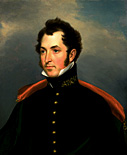
(1796-1846)
Mexican War Officer
New York artist John Vanderlyn had returned to the United States in 1815 after many years studying and painting in Europe. Encountering disappointments in his self-financed attempts to exhibit his historical works and cycloramas, he set up a studio in New York City in the 1820s, where he painted portraits to make a living.
John Vanderlyn (1775-1852)
A member of the first graduating class of the United States Military Academy at West Point (1818), Ringgold, an artillery officer, was on General Winfield Scott's staff when this portrait was painted. He was later promoted to major general in acknowledgment of his military innovations: the McClelland military saddle and the idea of flying artillery, a tactical concept employing artillery pieces that could be moved quickly from place to place. In 1846, in the first clash of the Mexican War, Ringgold led a small American force to victory at Palo Alto. Wounded, he died three days later. News of his death, the first of the war, created an explosion of national pride, and he became a hero.
Oil on canvas, circa 1825
National Portrait Gallery, Smithsonian Institution
Gift of the William Woodville Estate
NPG.80.208
Enlarged image
© 2002 Smithsonian Institution

